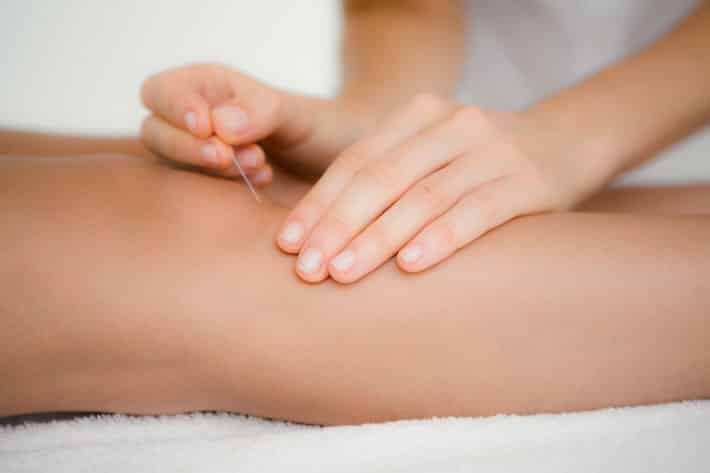Researchers conclude that #acupuncture reduces #pain #and stiffness while restoring physical functioning #for patients #with #knee osteoarthritis. #Using #an enzyme-linked immunosorbent assays, #the researchers made an important #finding. Acupuncture successfully downregulated osteoarthritis related proinflammatory plasma levels #of TNFα, IL-6, and apelin.
TNFα and IL-6 (interleukin 6) #are major proinflammatory cytokines involved #in osteoarthritis pathophysiology and are associated with radiographic osteoarthritis and knee cartilage #loss. Elevated levels are associated with knee pain (Stannus et al.). The adipokine apelin #is also correlated with inflammation, pain, and osteoarthritis.
Acupuncture downregulated levels of TNFα, IL-6, and apelin. Symptomatically, acupuncture relieved pain, stiffness, and restored physical functioning. #As #a result, the researchers provide both subjective and objective measures of improvement for patients with knee osteoarthritis.
TNFα plays a central role in cartilage matrix degradation and osteoarthritis bone resorption. Through the #use of #electroacupuncture, the researchers successfully downregulated TNFα and apelin in patients with osteoarthritis of the knees. Apelin is a newly discovered peptide. Identified in 1998, this peptide occurs #at the surface of osteoblasts. Apelin increases osteoblast proliferation, suppresses apoptosis, and is involved in inflammation, pain, and osteoarthritis.
The researchers measured significant downregulation of IL-6, #which is associated with radiographically confirmed knee osteoarthritis and cartilage loss. Normally, chondrocytes produce #low levels of IL-6. However, when knee osteoarthritis is present, IL-6 levels rise significantly. Acupuncture was successful in downregulating IL-6 for patients with knee osteoarthritis.
Plasma levels of apelin were recorded using an enzyme-linked immunosorbent assay made #by Phoenix Peptides (Burlingame, California). Plasma levels of TNFα and IL-6 levels were recorded using enzyme-linked immunosorbent assays made by Yuanye Bio-Tech (Shanghai, #China). The measurements were taken by the same person that was blinded #to #treatment assignments in order to prevent bias.
The single-blinded controlled trial with human subjects was conducted at the Shu Guang Hospital (Shanghai #Traditional #Medicine University). #All participants were diagnosed with knee osteoarthritis according to criteria determined by the American #College of Rheumatology.
Kellgren radiological severity needed to rate at least a grade II or III.
The researchers #used a protocolized acupuncture point prescription for all participants. Electroacupuncture was applied unilaterally to the affected leg, except for patients whose symptoms occurred bilaterally. In those instances, bilateral needling was applied.
The researchers compared two #types of electroacupuncture to determine the most #effective protocol. One group received low intensity electroacupuncture and the other group received #high intensity electroacupuncture. The results demonstrate that one type of electroacupuncture is the most effective. We’ll review the results in this article. Patients were randomly assigned to either group using randomization generated by the Statistical Package for the Social Sciences (#Chicago, Illinois).
Electroacupuncture was applied with single-use, sterile, filiform acupuncture #needles that were 30 mm in length and 30 gauge. Deqi was elicited at all acupoints prior to implementation of electroacupuncture. #Techniques used to elicit deqi were lifting, thrusting, twirling, and rotating of the needles. Using a Hans-200E electroacupuncture stimulator, the needles were attached to electrodes in pairs as listed in the following:
- GB34, ST34
- Xiyan (EX-LE4: Neixiyan. EX-LE5: ST35.)
- ST36, SP9
In this way, three pairs comprised of six acupuncture points were stimulated with electroacupuncture. Total electroacupuncture stimulation time per treatment #session was 30 minutes. High intensity was set to the patients’ tolerance levels at 5 – 6 mA. Low intensity electroacupuncture was set to the level at which a patient was able to detect electroacupuncture stimulation plus 1 mA. Low intensity electroacupuncture ranged between 2 – 2.5 mA for all patients.All patients received 16 electroacupuncture #treatments at a rate of once per day for 5 days. Next, patients had a two day break from treatments and the process was repeated. For the next two weeks, patients received treatments every 2 – 3 days. Unilateral acupuncture #needle insertion and stimulation was applied to the affected #side, except for patients with bilateral pain.
A weakness in the #study design is that all patients received 30 mg of etoricoxib #during the treatment period. Etoricoxib is a COX-2 (cyclooxygenase 2) inhibitor, which reduces production of prostaglandins. Despite the limitations of the study design, high intensity electroacupuncture proved to #be more effective than low intensity electroacupuncture. Because two types of electroacupuncture were compared in separate, controlled groups and each acupuncture protocol produced significantly different biochemical and symptomatic improvements, acupuncture was identified as achieving specific positive patient outcomes.
The researchers note that both groups “markedly improved from baseline,” however, improvements in stiffness and physical functioning were significantly greater in the high intensity electroacupuncture group. Also, apelin levels reduced more significantly in the high intensity electroacupuncture group. IL-6 did not reduce in the low intensity group but significantly reduced in the high intensity electroacupuncture group. As a result, the clinical improvements differing between the low and high intensity electroacupuncture groups are not attributable to etoricoxib intake.
The researchers conclude that high intensity electroacupuncture “suppresses proinflammatory cytokines and improves pain and function in patients with symptomatic KOA [knee osteoarthritis].” In addition, high intensity acupuncture “provides better improvement in the disease-specific quality of life of KOA patients and a greater modulation of cytokine section.” We look forward to additional #research #on this topic.
References:
Ju Z, Guo X, Jiang X, Wang X, Liu S, He J, Cui H, Wang K. Electroacupuncture with different current intensities to #treat knee osteoarthritis: a single-blinded controlled study. International journal of clinical and experimental medicine. 2015;8(#10):18981.
Stannus O, Jones G, Cicuttini F, Parameswaran V, Quinn S, Burgess J, Ding C. Circulating levels of IL-6 and TNFα are associated with knee radiographic osteoarthritis and knee cartilage loss in older adults. Osteoarthritis Cartilage 2010; 18: 1441-1447.
Stannus OP, Jones G, Blizzard L, Cicuttini FM, Ding C. Associations between serum levels of inflammatory markers and change in knee pain over 5 years in older adults: a prospective cohort study. Ann Rheum Dis #2013; 72: 535- 540.

